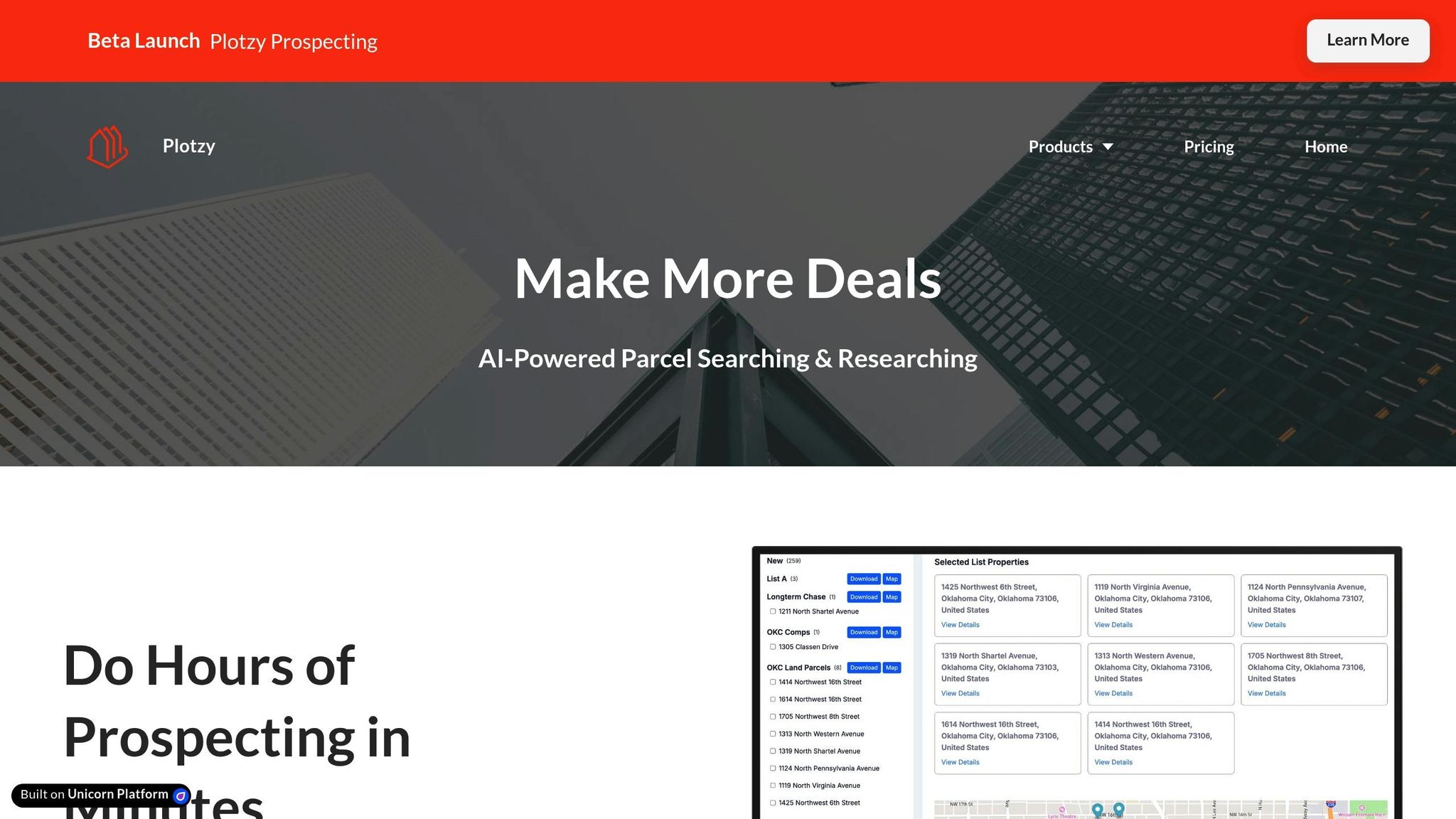AI-powered property use reports are changing commercial real estate. They simplify zoning checks, detail development options, and provide actionable insights for brokers, developers, and investors. Here's what you need to know:
- What they include: Zoning rules, property details, financial data, and compliance information.
- Why they matter: They speed up due diligence, identify risks, and help plan investments.
- AI's role: AI tools analyze zoning laws, automate data collection, and generate detailed reports quickly.
For anyone in commercial real estate, these reports save time and help make smarter decisions.
AI in Commercial Real Estate Debt Risk Analysis
Main Parts of a Property Use Report
A property use report typically includes several key sections to provide a clear understanding of the property.
Owner Details and Contact Information
- Legal name and entity type of the current owner (e.g., individual, LLC, corporation)
- Primary contact information: phone, email, and mailing address
- Details of any property management company involved
- History of ownership, including past transfers and duration
- Tax identification numbers and business registrations
Having accurate ownership details helps ensure smooth communication and simplifies due diligence processes.
Zoning Rules and Permitted Uses
- Current zoning classification and district designation
- Permitted, conditional, and prohibited property uses
-
Building envelope restrictions, such as:
- Maximum building height
- Setback requirements
- Lot coverage limits
- Floor Area Ratio (FAR) restrictions
- Parking requirements based on the property's use
- Records of historical variances or special permits
- Non-conforming use status, if applicable
Understanding these zoning details is crucial for assessing what can and cannot be done with the property.
Property Details and Financial Information
After zoning is reviewed, it's important to examine the physical and financial aspects of the property:
-
Physical characteristics
- Total square footage and number of stories
- Year built and construction type
- Lot size and topography
- Flood zone classification
-
Financial data
- Assessed value, tax history, and recent sales data
- Any outstanding liens or encumbrances
- Insurance coverage and requirements
- Operating expenses and maintenance costs
-
Building systems and compliance
- Recent renovations or upgrades
- Current building code compliance
- Fire safety adherence
- Any unresolved citations or violations
This section ties together key physical and financial insights to provide a complete picture of the property.
Using Property Reports in Commercial Real Estate
Finding and Evaluating Sites
Property reports are an important resource for pinpointing commercial properties. They offer detailed information on zoning rules, allowed uses, and development potential for specific parcels. With this data, real estate professionals can:
- Evaluate building potential (e.g., Floor Area Ratio or FAR)
- Understand parking requirements
- Spot redevelopment possibilities
- Confirm zoning compliance
When assessing a site, it’s critical to look at both its current state and future development prospects, especially for properties near transit hubs.
Property Research Methods
Effective property research involves a detailed review of property reports. Focus on these areas:
- Check zoning classifications and ensure compliance with building, fire, and occupancy standards.
- Investigate future plans, such as potential zoning changes or infrastructure upgrades.
This analysis lays the groundwork for strategic investment decisions.
Investment Planning
Property reports are key to making smart investment choices. They help investors with:
Finding Value-Add Opportunities
Use zoning and development data to identify ways to enhance property value, such as:
- Maximizing unused FAR
- Exploring changes in permitted uses
- Considering expansion possibilities
Assessing Risks
Evaluate potential risks, including:
- Non-conforming uses
- Compliance challenges
- Upcoming zoning changes
Developing Long-Term Strategies
Plan ahead by focusing on:
- Current use: Look at permitted uses, occupancy limits, and parking availability.
- Development potential: FAR, height limits, and setback restrictions.
- Future opportunities: Track zoning amendments and local development trends.
Keeping an eye on zoning updates and jurisdictional changes ensures your investments remain aligned with market opportunities.
sbb-itb-11d231f
Plotzy's AI Features for Property Reports

Plotzy integrates AI to streamline property use reporting, offering tools that simplify and improve decision-making in commercial real estate.
Quick Property Search Tools
Plotzy's AI makes property searches fast and efficient, using criteria like zoning, FAR (Floor Area Ratio), and size. The platform goes beyond basic searches with advanced options, such as:
- Zoning classifications – Locate properties based on permitted uses.
- Development potential – Filter properties by FAR to assess build possibilities.
- Property characteristics – Sort by lot and building size.
With hundreds of filters, users can refine their search and view results on an interactive map. This map highlights spatial relationships, helping users pinpoint the best opportunities. The search process integrates seamlessly with deeper data analysis for a more comprehensive approach.
Data Collection and Analysis
Plotzy's AI gathers essential property data from multiple sources, including:
- County tax assessor records – Offering official property details.
- Municipal zoning codes – Highlighting land use regulations.
- Transaction history – Recording past sales and ownership changes.
Using this data, Plotzy generates detailed property reports. These reports include metrics like maximum buildable area, parking requirements, setback rules, and height restrictions. Such data provides a solid foundation for making informed decisions and reaching out to property owners.
Owner Contact Tools
Plotzy's AI simplifies the process of finding and verifying owner information. By automating owner identification, confirming mailing addresses, and cross-referencing public records, the platform saves users 30–60 minutes per property. This time-saving feature allows professionals to focus more on closing deals rather than manual research.
Conclusion
AI-powered property use reports are transforming how decisions are made in commercial real estate. By cutting down research time and boosting accuracy, these tools offer detailed insights into zoning rules, development options, and economic prospects.
Beyond these immediate perks, professionals are now leveraging AI to stay ahead of the competition. These tools allow for the evaluation of multiple properties at once, enabling quicker, data-informed decisions, as discussed earlier.
As the industry continues to evolve, AI's role in property use reporting will only grow. The ability to swiftly analyze zoning regulations, assess development opportunities, and connect with property owners gives professionals a clear edge in today’s fast-moving market.
For brokers, developers, and investors, adopting AI-powered tools isn’t just about working faster - it’s about spotting and seizing profitable opportunities before others do. In the ever-changing world of commercial real estate, AI is becoming a key ingredient in closing successful deals.
FAQs
How can AI-powered property use reports streamline due diligence in commercial real estate?
AI-powered property use reports simplify and speed up the due diligence process in commercial real estate by automating complex tasks like analyzing zoning laws, property details, and municipal regulations. These tools can process large datasets quickly, saving time and reducing the risk of human error.
By providing accurate and detailed insights, AI-driven reports help stakeholders make informed decisions faster, whether it's for site selection, property research, or identifying the best land use opportunities. This efficiency ensures a more seamless and reliable due diligence process, ultimately improving outcomes for real estate professionals.
What zoning factors should you review to assess a property's development potential?
When evaluating a property's development potential, it's important to review key zoning factors such as setback requirements, building height and size limits, allowed property uses, and density restrictions. Additionally, consider regulations for lot frontage, yard dimensions (front, rear, and side), off-street parking requirements, and the number of dwelling units permitted.
These zoning details can significantly impact how a property can be used and developed, making them essential for informed decision-making in real estate projects.
How does Plotzy's AI simplify finding and verifying property ownership details?
Plotzy's AI streamlines the process of locating and verifying property ownership by analyzing public records, zoning data, and municipal databases. It quickly consolidates this information into a clear, easy-to-read report, saving you time and effort.
By automating data collection and verification, Plotzy ensures that you receive accurate and up-to-date property ownership details, helping you make informed decisions for site selection, property research, or other real estate needs.


